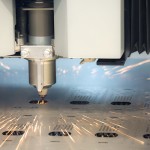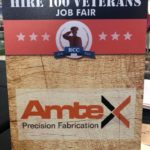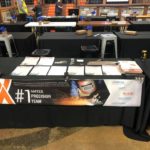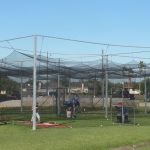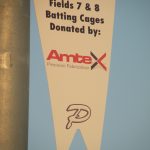Amtex Precision Fabrication cuts, bends, welds, thrives
THE TUBE & PIPE JOURNAL JULY/AUGUST 2017
JULY 20, 2017
BY: ERIC LUNDIN
“We don’t make anything in the U.S. anymore” and “Manufacturing is dirty and dangerous” are two mantras of the poorly informed. Jacob Melton proved both notions wrong when he turned his back on a successful career developing software for the financial industry and purchased a fabrication shop.

Jacob Melton, one of the owners of Amtex Precision Fabrication Inc., left a white-collar career in the financial sector to pursue a career in metal fabrication.
If you listen to the chatter about manufacturing careers—chatter from poorly informed sources—you’ll hear two opposing views. On one hand, such careers don’t exist; on the other hand, nobody wants to work in manufacturing. The chatter goes like this:
- “We don’t make anything in the U.S. anymore.”
- “Manufacturing is dirty and dangerous.”
This combination fails the logic test. It’s impossible to have dirty and dangerous manufacturing jobs if we don’t make anything anymore. Both can’t be true, and in reality neither is true. Two pieces of data knock them down like a house of cards.
First, according to The World Bank, U.S. manufacturing generates 17 percent of the world’s manufactured product. That’s not bad for a country that has 4 percent of the world’s population. Second, workplaces keep getting safer. The Occupational Safety and Health Administration reported an injury rate of 14.5 incidents per hundred workers in metal fabrication in 1995. By 2015, that rate had fallen by nearly 70 percent to 4.5 incidents per hundred workers.
If you want to get a better understanding of potential for U.S. manufacturing, you could ask Jacob Melton, co-owner of Amtex Precision Fabrication Inc., Manvel, Texas. After completing a bachelor’s degree in business, Melton worked for several years for finance and investment firms—first Thomson Reuters and later Morningstar—and then made the move to manufacturing.
If the uninformed chatter is to be believed, he gave up a professional career in finance so he could make nothing in a dirty, dangerous environment.
A Big Transition
A native of the Houston area, Melton had just indirect contact with steel and fabrication when he was growing up. His grandfather ran a scrap yard in the 1940s, and that business transitioned to become a steel distributor on the 1950s. Melton’s father took over the business and ran it for many years, selling it in 2000.
The company didn’t do much fabrication work. Melton recalled that his father had a machine that rolled material up to 4 inches thick and a burn table. He’d buy damaged material, mainly beam, and use it to make counterweights. Although Melton never worked for the company, he was well aware that two generations of his family made a nice living from dealing with steel.
After graduating from a liberal arts school with a degree in business, Melton took two successive jobs managing software products. The software did investment analysis and forecasting, demonstrating the effect of growth of specific stocks in a client’s portfolio. Melton oversaw the modification of the software, tailoring it to the needs of various clients.
“It was interesting work, especially for a 25- or 26-year-old kid,” Melton said. He had quite a bit of latitude in his career, but after six years or so in the financial world, Melton started thinking about a different path. He was looking for a different location, too. Winters on the East Coast and in Chicago had taken a toll. Melton really wanted to do his own thing, and he wanted to do it in Houston, so he quit Morningstar and moved back to his hometown.
Back in Houston, he had a few discussions with his parents about various business opportunities and did some research through a business broker. He considered buying a variety of businesses—a sandwich shop franchise, a company that makes commercial gutters, a barbeque pit manufacturer, a commercial food distributor that prepares meals for airlines, and a machine shop. One by one, he started crossing them off the list. The reasons were as varied as the companies themselves and the markets they were in: Too few potential customers, too many (finicky) customers, product range too narrow, market too competitive, and so on. He put in a bid on the machine shop, but it didn’t work out.

Figure 1
Most fabricators rely on homegrown ingenuity once in a while, and Amtex is no different. It added a chuck system to its laser bed so its laser can handle tubular parts, and then the Amtex staff also suggested an engineering change for this tube. Rather than weld a filter unit to the tube’s outside diameter, they suggested making the exit port a small slit, just 0.008 in. wide, which effectively works as a filter.
When he discovered a local fabricator, Amtex Precision Fabrication Inc., Manvel, Texas, he realized that he had found the right company. He hit it off with the owner, so he figured a change in ownership would be a relatively smooth transition. He also thought that the business had two chief attributes: A solid foundation and growth potential.
“It was a diamond in the rough,” he said.
Making It in Manvel
Equipped for laser cutting, press brake bending, welding, grinding, and light machining, the company can handle sheets up to 5 by 10 feet and has American Welding Society certifications for structural work in carbon steel and stainless steel (AWS D 1.1 and D 1.6). It is also certified by the American Society of Mechanical Engineers for boiler code work. Also, the Amtex staff developed a rotary axis for its laser cutting machine, so in addition to flat products, it can cut pipe and tube as well (see Figure 1).
The company advertises that it specializes in stainless steel and aluminum, which hints at applications in corrosive environments, such as marine and chemical processing. It serves customers in industries as varied as high-end electronics, industrial machines and equipment, instrumentation and test equipment, medical, oil and gas, and petrochemical.
Amtex wasn’t a big shop when Melton bought it in 2005, and it’s not big now (see Figure 2). Melton figured this was to his advantage. Without a bureaucracy, an enterprise resource planning system, vast amounts of overhead, and a rigid schedule, the company thrives on flexibility, the key to top-notch customer service. The shop is small and the orders are small, so it’s easy to turn around a rush order, and a customer needing something in a hurry can get in touch with Melton easily (he doesn’t have a secretary, so he answers a lot of calls himself).
Diversifying. Like most small businesses, Amtex went through a period in which it had too many eggs in one basket. When Melton bought the company, one customer accounted for almost 80 percent of its revenue. This continued for several years, and Melton gave a lot of thought to the unthinkable. Then the unthinkable happened. The customer moved from its nearly local location, San Antonio, to not at all local Buffalo, N.Y. Overnight the shipping distance increased from 200 miles to 1,500 miles, and because much of the work involved large enclosures, Amtex lost all of that business. Amtex still ships some parts to that customer, but it’s not a big part of the company’s revenue stream anymore.
“It was probably the best situation,” Melton said. He had to scramble to find new customers, and in the process, he changed the business dynamic. These days his biggest customer accounts for just 12 percent of the company revenue, a much stronger position,
It also prepared him to act fast when oil prices fell and his petroleum-related and petroleum-dependent business took a nosedive. Formerly employing 22 people and running two shifts, Melton had to make quite a few difficult decisions. Now staffed with 13 employees on one shift, he’s slowly building the business back up without much help from the oil and gas industry.
Consoles. The company does a lot of work making consoles for the controls and electronic systems for various boats, both civilian and military. Each boat is different, each control system layout is different, and therefore each console is different. A console can be as simple as a rectangular box, but in most cases they are extremely complex. In one recent case, the engineering work alone took 80 hours.
Habitats. The Houston Zoo came knocking to see if Amtex would build an enclosure to function as a habitat and a display for its caiman lizards. Melton didn’t know anything about lizards, but he was willing to learn.

Figure 2
Flexibility is a key capability at Amtex. It augments its day-to-day press brake capacity with several small brakes that it uses when order volumes surge.
“We worked with their exhibit team on the enclosure’s design,” Melton said. “It had all sorts of criteria that we don’t normally deal with. It needed a perforated roof for ventilation, brackets for hanging lights, and an access door so staff could enter. It also had to have large glass walls for viewing the habitat, so that led us to discussions with the glass vendor.”
This project was unusual for another reason. It’s a rare instance in which Amtex’s portion of the work is essentially invisible. Even though it’s a large project, measuring 8 ft. wide, 10 ft. long, and 8 ft. tall, viewers don’t see much of the stainless steel at all. The staff created a tropical habitat to mimic the lizard’s natural home—the jungles of South America—and it’s so complete that it obscures most of the stainless steel surfaces.
Fencing Project. Another project, one that Melton currently is bidding on, will be much more visible. If Amtex gets the job, it will be a strikingly aesthetic project.
“The customer asked about posts for a fence,” Melton said. Wood is a common fencepost material, but wood doesn’t last too long. The customer decided to investigate steel posts but hoped for something that had the look of wood. Their initial concept called for an embossing or hammering process of some sort to impart a wood-like texture. Melton came up with a different concept. An avid hunter, Melton has added a camouflage pattern to a couple of shotguns using hydrographics, so he suggested this process for the posts.
“They can make all sorts of patterns,” Melton said. “Camouflage, wood grain, you name it, they can probably do it.” A bonus is that if a post gets scratched, it can be powder-coated and dipped again to restore its finish. If the customer’s maintenance staff takes care in inspecting the posts for scratches and damage frequently and has any damage remedied quickly, the dipped posts could have an almost limitless service life.
The drawback is in the hydrographics business. Many hydrographics outfits are run out of the owner’s garage and set up for small parts, like shotgun stocks, so Melton had trouble finding one with a tank size big enough to handle a post. Getting a prototype was a hassle, but he finally got one done (see Figure 3).
“If we get the contract, we’ll definitely have to do the hydrographics ourselves,” he said.
Supporting Local Baseball. Football is huge in Texas, but baseball isn’t to be overlooked.
“One of our engineers, Adrian Wagner, is on the board of directors of Pearland Little League,” Melton said, referring to a league that has more than 1,100 players, fields more than 100 teams, and has made too many appearances at the Little League World Series to count. To say that Texans, Pearland, and Amtex take baseball seriously would be an understatement of epic proportions.
“We’ve made a few things for the league,” Melton said. A notable project was a batting practice structure subdivided into four separate batting cages.

Figure 3
It looks like wood, but it’s made of metal. The hydrographic process uses dipping to impart a pattern that often has a level of detail and clarity that defies belief.
“Adrian designed it and oversaw the construction of it,” Melton said. Materials and shop time were donated by Amtex.
Making History in Houston
It’s not often that a fabricator gets to participate directly in something breathtakingly historic, but Melton was in the right place at the right time. Because Amtex does so much work in bending metal to make consoles for control systems, it was invited to bid on a project to be installed in Houston. It wasn’t just any old place in Houston, but the Lyndon B. Johnson Space Center. It wasn’t just any old console for the space center, but one that would house mission control systems for the International Space Station. The consoles weren’t going into any old room at the space center, but the same room that was used for mission control when the U.S. space program was in its heyday, the era of the Apollo missions. Yes, that room (see Figure 4).
“The room hadn’t been used for some time, so they opened it with a big reception,” Melton said. “They invited past astronauts and other dignitaries, and the contractors who had worked on making the equipment, and they opened it officially with a ribbon-cutting ceremony.”
It didn’t end there. The staff at NASA had a surprise in store. The people in this room—the room that received Neil Armstrong’s famous message as he set foot on the moon—got to listen to a heartfelt and welcoming message from one of the astronauts who was aboard the International Space Station at the time.
“It was an unforgettable experience,” he said.
From Melton’s perspective, “We don’t make things in the U.S. anymore” is about as far from the truth as you can get. The U.S. really does make things. The U.S. manufacturing industry makes things day after day, week in and week out, all year long.
Most days it makes manufactured products. Some days it makes history.
Amtex Precision Fabrication Inc., 3920 Bahler Ave, Manvel, TX 77578, 281-489-7042, info@amtexprecision.com, https://amtexprecision.com

Figure 4
Houston-area fabricator Amtex Precision Fabrication got a chance to contribute to something monumental when it won a NASA contract. It built the consoles for the International Space Station control room, which was the mission control room during the Apollo era.

